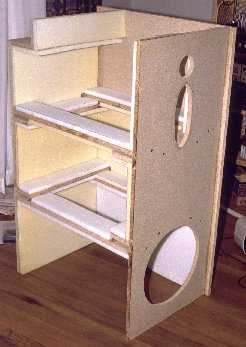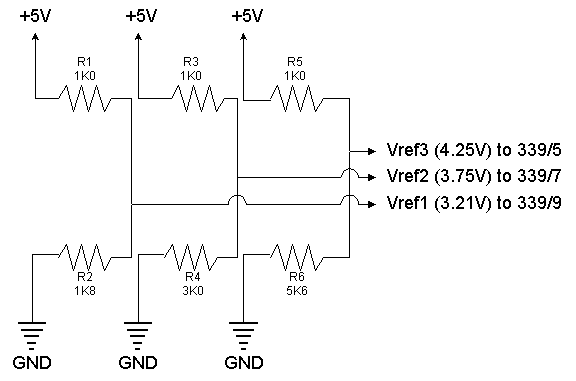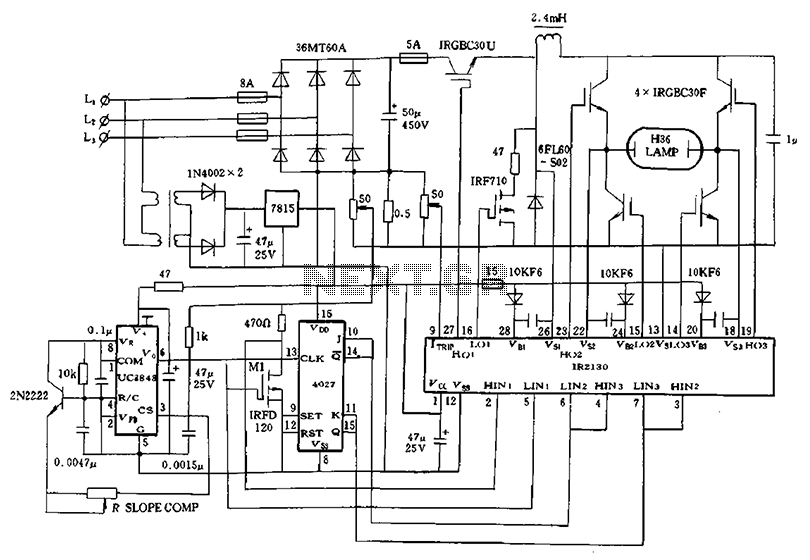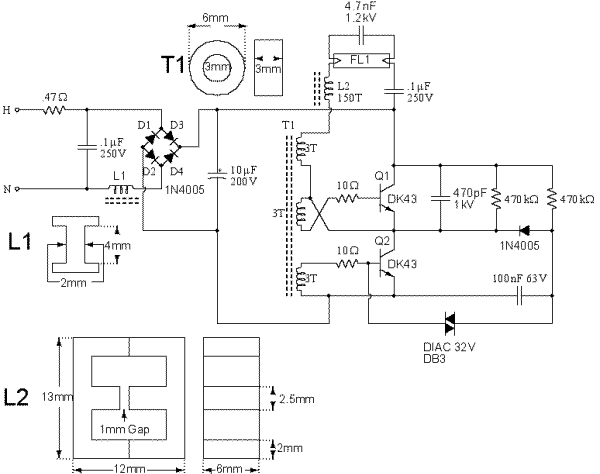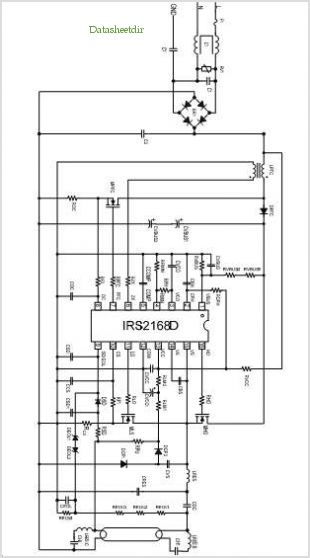
Plasma Ball Plans
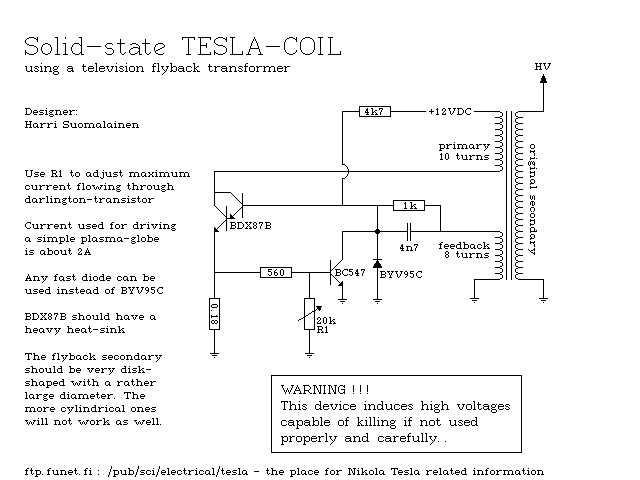
Plasma Globes were invented by Nikola Tesla before 1892. Glass-enclosed Tesla coil terminals containing low-pressure gases were part of his effort to develop a new lighting source not covered by Edison patents. The same device became an art object when William Parker, an intern at the Exploratorium museum in San Francisco, redesigned the old "Argon Candle" science exhibit to produce a long plasma streamer. Parker named the device "AM Lightning." His later devices were spherical and contained various gas mixtures that produced a wide variety of nonlinear plasma phenomena. Parker exhibited these in Cambridge, Massachusetts, at the MIT Compton Gallery in 1985.
To create a plasma globe, first build a small Tesla Coil using a flyback transformer, which can be sourced from old television sets or non-functional computer monitors. The coil must generate a spark of approximately 1.5 cm in length. Obtain a 40-watt, 4-inch clear spherical light bulb from a large hardware store. Connect the high-voltage lead from the mini Tesla coil to the base of the light bulb, ensuring that the specific contact used does not matter. With the lights turned off, activate the coil to observe purple "plasma fingers" emanating from the filament supports within the bulb. For enhanced effects, aluminum foil can be taped to one side of the bulb and grounded, or black spray paint can be applied to the foil to improve visual contrast.
For a more ambitious project, consider constructing a custom glass globe. Using a glass jar or a boiling flask from a chemistry supplier, seal it with a three-hole stopper. Insert two hoses: one for gas injection and another for gas outlet. Ensure the inlet hose is pushed deep into the flask to effectively push air out. A paper towel or fiberglass can be used at the end of the gas tube as a diffuser to minimize turbulent mixing. Insert a wire through one of the holes as the high-voltage terminal, centering the tip inside the flask. Activate the Tesla coil and use pure argon to slowly replace the nitrogen in the glass globe. As the nitrogen and oxygen are displaced, the corona discharge from the wire will increase in size. Once the discharge appears large and white, stop the argon flow and seal the hoses. Epoxy can be used to seal the stopper holes, but silicone caulk should be avoided due to its acetic acid fumes, which can disrupt the plasma effect.
It is important to note that when certain bulbs are placed atop a Tesla coil, they may not produce visible plasma streamers, resulting instead in a dark space inside the bulb with flickering blue, white, or green light, indicating a hard vacuum. At high voltages (above 10 kV), such bulbs can emit soft x-rays as electrons collide with the glass, causing fluorescence. Although the x-ray intensity is generally low and insufficient to illuminate a fluorescent screen, precautions should be taken. The x-rays may penetrate aluminum foil and cardboard but not steel. A Geiger counter may register clicks only if it has a thin window for alpha particles.
To minimize any x-ray exposure, it is advisable to use only the larger 4-inch spherical bulbs for plasma globe experiments and avoid smaller aquarium bulbs that may fluoresce green. Additional resources for constructing plasma globes and related devices can be found in various electronics magazines and libraries.Plasma Globes were invented by Nikola Tesla some time before 1892. Glass-enclosed Tesla coil terminals containing low-pressure gases were part of his effort to develop a new source of lighting not covered by the Edison patents. The same device became an art object when William Parker, an intern at the Exploratorium museum in SF, redesigned the ol
der "Argon Candle" science exhibit to produce a long plasma streamer. Parker named the device "AM Lightning". His later devices were spherical and contained various gas mixtures producing a wide variety of nonlinear plasma phenomena. Parker exhibited these in Cambridge MA at the MIT Compton Gallery in 1985. First built a tiny Tesla Coil based on a flyback transformer. Flyback units can be had from old TV sets or dead computer monitors. Build your Tesla Coil using one of the following schematics: Your coil needs to be able to generate a spark of about 1.
5cm length. Next, obtain a "decorator" 40 watt 4-inch clear spherical light bulb. Large hardward stores like Ernst or Fred Meyer carry these. Connect the high voltage lead from your mini tesla coil to the base of the light bulb. (It doesn`t matter which light bulb contact you use. ) Turn off the lights and turn on your coil, and you`ll see purple "plasma fingers" spewing out of the filament supports in the light bulb. (In some cases you can improve this by taping some aluminum foil to one side of the bulb. Connect the foil to ground. Even better, you can improve the visual contrast. Just use black spray-paint to coat the foil. ) If you want to get ambitious you can eliminate the light bulb. Instead build your own glass globe. Use a glass jar, or better yet a boiling flask from a mailorder chemistry supplier or a lab glass outfit.
Stopper with a 3-hole stopper. Provide two hoses, one to inject gas, the other as an outlet. Push the inlet hose deep into the flask so the injected gas can push the air ahead of it. Tape a layer of paper towel around the end of the gas tube inside the bulb. (Or perhaps stuff some fiberglas in the tube end. ) This acts as a gas diffuser to prevent turbulent mixing. Insert a wire into one hole as the H. V. terminal, with the tip of the wire centered in the flask. Turn on the tesla coil, turn out the lights, then use pure Argon to slowly flush the nitrogen out of the glass globe (welding argon is pure enough. Note that argon is slightly heavier than air. ) As the N2 and O2 is replaced by the Argon, the small corona discharge on the wire in the globe will grow larger and larger.
When the discharge is large and white, turn off the argon and clamp the hoses. Seal the stopper holes with epoxy if desired (don`t use silicone caulk, the acetic acid fumes destroy the plasma effect. ) A note about x-rays. When placed atop a Tesla coil, some small bulbs fail to produce purple streamers of plasma. Instead the space inside the bulb remains dark. But the glass flickers blue, or white, or sometimes green. This shows that the bulb contains a fairly hard vacuum. And at high voltage (above 10KV, ) such a bulb will produce soft x-rays as electrons slam into the glass and make it fluoresce.
USUALLY the x-ray intensity is insignificant. They`re far too little to light up a fluorescent screen. (No viewing your own bones! Aw too bad. ) They might pass through aluminum foil and cardboard, but they won`t pass through steel. But they will make a geiger counter click, but only if the GM probe has a thin window (for alpha particles. ). The response of the alpha-window geiger counter is about the same as that for a hunk of uranium mineral.
Most types of small appliance bulbs, aquarium lights, exit sign lamps, etc. , will produce weak low-energy x-rays when used as a "plasma globe. " I`ve heard that the x-ray output is a bit higher if the filament is lit by a floating battery. And it`s much higher if a piece of grounded metal foil is glued to the end of the bulb. So, to avoid even the slightest x-ray hazard, use only the large 4-inch spherical bulbs for your "plasma globe. " Stay away from those small green-fluorescing aquarium bulbs! Here`s some radiation info, compare x-ray hazards to the risk of canoe trips and eating peanut butter.
Aug 1997 ELECTRONICS NOW (magazine), Build the Poor Man`s Plasma Globe, by R. Iannini and Marc Spiwak. Use a decorative spherical light bulb and a 12v power supply based on FETs and a flyback xformer. 1990 RADIO ELECTRONICS ELECTRONIC EXPERIMENTERS HANDBOOK (magazine), ELECTRONIC TORNADO, by Robert Iannini. Schematic and construction instructions for a variable power supply for a plasma sphere, with audio input, variable pulse and intensity (note: plasma spheres don`t really need a vacuum pump, use a jar full of pure helium or pure argon at 1-ATM) 1990 RADIO ELECTRONICS ELECTRONIC EXPERIMENTERS HANDBOOK (magazine), (magazine), BUILD THE LIGHTNING BULB, By Vinny Vollono.
Plans for a simple plasma sphere based on an automotive ignition coil, a triac, and a 6" light bulb Back issues of RADIO ELECTRONICS magazine, HANDS-ON ELECTRONICS magazine, and EXPERIMENTER`S HANDBOOK magazine are available from your local public library via the Interlibrary Loan service. Contact the reference desk. OLD LINKS GONE BAD Try, "The Wayback Machine" It offers billions of old websites and even some of the graphics.
But it`s not searchable. You have to know the URL of the old site. Quick link to old sites: simply add this prefix to any expired URL: 🔗 External reference
To create a plasma globe, first build a small Tesla Coil using a flyback transformer, which can be sourced from old television sets or non-functional computer monitors. The coil must generate a spark of approximately 1.5 cm in length. Obtain a 40-watt, 4-inch clear spherical light bulb from a large hardware store. Connect the high-voltage lead from the mini Tesla coil to the base of the light bulb, ensuring that the specific contact used does not matter. With the lights turned off, activate the coil to observe purple "plasma fingers" emanating from the filament supports within the bulb. For enhanced effects, aluminum foil can be taped to one side of the bulb and grounded, or black spray paint can be applied to the foil to improve visual contrast.
For a more ambitious project, consider constructing a custom glass globe. Using a glass jar or a boiling flask from a chemistry supplier, seal it with a three-hole stopper. Insert two hoses: one for gas injection and another for gas outlet. Ensure the inlet hose is pushed deep into the flask to effectively push air out. A paper towel or fiberglass can be used at the end of the gas tube as a diffuser to minimize turbulent mixing. Insert a wire through one of the holes as the high-voltage terminal, centering the tip inside the flask. Activate the Tesla coil and use pure argon to slowly replace the nitrogen in the glass globe. As the nitrogen and oxygen are displaced, the corona discharge from the wire will increase in size. Once the discharge appears large and white, stop the argon flow and seal the hoses. Epoxy can be used to seal the stopper holes, but silicone caulk should be avoided due to its acetic acid fumes, which can disrupt the plasma effect.
It is important to note that when certain bulbs are placed atop a Tesla coil, they may not produce visible plasma streamers, resulting instead in a dark space inside the bulb with flickering blue, white, or green light, indicating a hard vacuum. At high voltages (above 10 kV), such bulbs can emit soft x-rays as electrons collide with the glass, causing fluorescence. Although the x-ray intensity is generally low and insufficient to illuminate a fluorescent screen, precautions should be taken. The x-rays may penetrate aluminum foil and cardboard but not steel. A Geiger counter may register clicks only if it has a thin window for alpha particles.
To minimize any x-ray exposure, it is advisable to use only the larger 4-inch spherical bulbs for plasma globe experiments and avoid smaller aquarium bulbs that may fluoresce green. Additional resources for constructing plasma globes and related devices can be found in various electronics magazines and libraries.Plasma Globes were invented by Nikola Tesla some time before 1892. Glass-enclosed Tesla coil terminals containing low-pressure gases were part of his effort to develop a new source of lighting not covered by the Edison patents. The same device became an art object when William Parker, an intern at the Exploratorium museum in SF, redesigned the ol
der "Argon Candle" science exhibit to produce a long plasma streamer. Parker named the device "AM Lightning". His later devices were spherical and contained various gas mixtures producing a wide variety of nonlinear plasma phenomena. Parker exhibited these in Cambridge MA at the MIT Compton Gallery in 1985. First built a tiny Tesla Coil based on a flyback transformer. Flyback units can be had from old TV sets or dead computer monitors. Build your Tesla Coil using one of the following schematics: Your coil needs to be able to generate a spark of about 1.
5cm length. Next, obtain a "decorator" 40 watt 4-inch clear spherical light bulb. Large hardward stores like Ernst or Fred Meyer carry these. Connect the high voltage lead from your mini tesla coil to the base of the light bulb. (It doesn`t matter which light bulb contact you use. ) Turn off the lights and turn on your coil, and you`ll see purple "plasma fingers" spewing out of the filament supports in the light bulb. (In some cases you can improve this by taping some aluminum foil to one side of the bulb. Connect the foil to ground. Even better, you can improve the visual contrast. Just use black spray-paint to coat the foil. ) If you want to get ambitious you can eliminate the light bulb. Instead build your own glass globe. Use a glass jar, or better yet a boiling flask from a mailorder chemistry supplier or a lab glass outfit.
Stopper with a 3-hole stopper. Provide two hoses, one to inject gas, the other as an outlet. Push the inlet hose deep into the flask so the injected gas can push the air ahead of it. Tape a layer of paper towel around the end of the gas tube inside the bulb. (Or perhaps stuff some fiberglas in the tube end. ) This acts as a gas diffuser to prevent turbulent mixing. Insert a wire into one hole as the H. V. terminal, with the tip of the wire centered in the flask. Turn on the tesla coil, turn out the lights, then use pure Argon to slowly flush the nitrogen out of the glass globe (welding argon is pure enough. Note that argon is slightly heavier than air. ) As the N2 and O2 is replaced by the Argon, the small corona discharge on the wire in the globe will grow larger and larger.
When the discharge is large and white, turn off the argon and clamp the hoses. Seal the stopper holes with epoxy if desired (don`t use silicone caulk, the acetic acid fumes destroy the plasma effect. ) A note about x-rays. When placed atop a Tesla coil, some small bulbs fail to produce purple streamers of plasma. Instead the space inside the bulb remains dark. But the glass flickers blue, or white, or sometimes green. This shows that the bulb contains a fairly hard vacuum. And at high voltage (above 10KV, ) such a bulb will produce soft x-rays as electrons slam into the glass and make it fluoresce.
USUALLY the x-ray intensity is insignificant. They`re far too little to light up a fluorescent screen. (No viewing your own bones! Aw too bad. ) They might pass through aluminum foil and cardboard, but they won`t pass through steel. But they will make a geiger counter click, but only if the GM probe has a thin window (for alpha particles. ). The response of the alpha-window geiger counter is about the same as that for a hunk of uranium mineral.
Most types of small appliance bulbs, aquarium lights, exit sign lamps, etc. , will produce weak low-energy x-rays when used as a "plasma globe. " I`ve heard that the x-ray output is a bit higher if the filament is lit by a floating battery. And it`s much higher if a piece of grounded metal foil is glued to the end of the bulb. So, to avoid even the slightest x-ray hazard, use only the large 4-inch spherical bulbs for your "plasma globe. " Stay away from those small green-fluorescing aquarium bulbs! Here`s some radiation info, compare x-ray hazards to the risk of canoe trips and eating peanut butter.
Aug 1997 ELECTRONICS NOW (magazine), Build the Poor Man`s Plasma Globe, by R. Iannini and Marc Spiwak. Use a decorative spherical light bulb and a 12v power supply based on FETs and a flyback xformer. 1990 RADIO ELECTRONICS ELECTRONIC EXPERIMENTERS HANDBOOK (magazine), ELECTRONIC TORNADO, by Robert Iannini. Schematic and construction instructions for a variable power supply for a plasma sphere, with audio input, variable pulse and intensity (note: plasma spheres don`t really need a vacuum pump, use a jar full of pure helium or pure argon at 1-ATM) 1990 RADIO ELECTRONICS ELECTRONIC EXPERIMENTERS HANDBOOK (magazine), (magazine), BUILD THE LIGHTNING BULB, By Vinny Vollono.
Plans for a simple plasma sphere based on an automotive ignition coil, a triac, and a 6" light bulb Back issues of RADIO ELECTRONICS magazine, HANDS-ON ELECTRONICS magazine, and EXPERIMENTER`S HANDBOOK magazine are available from your local public library via the Interlibrary Loan service. Contact the reference desk. OLD LINKS GONE BAD Try, "The Wayback Machine" It offers billions of old websites and even some of the graphics.
But it`s not searchable. You have to know the URL of the old site. Quick link to old sites: simply add this prefix to any expired URL: 🔗 External reference
